September 2010
Haste ye Back
Scotland
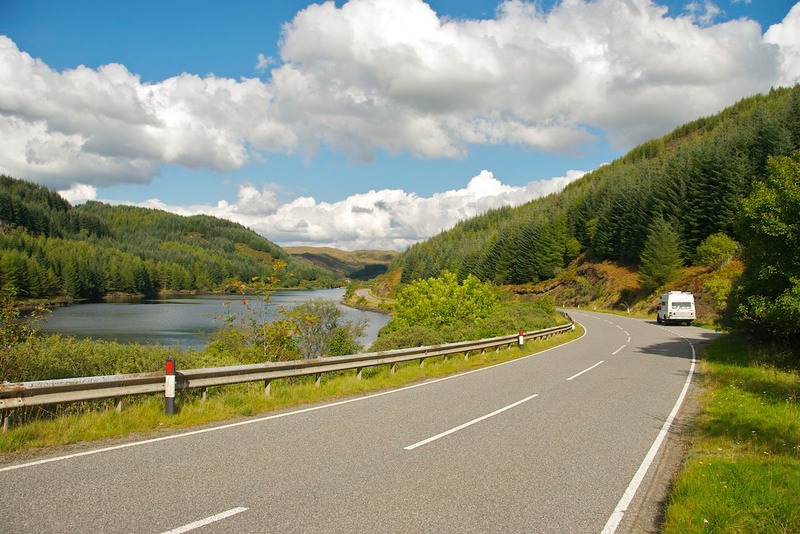
Haste Ye Back – it’s on the signs as you leave each of the small towns and villages in Scotland, urging your return. We have taken it to heart, and know we will be back. Scotland has been a treat, a revelation to us; we thought we were in heaven in Wales, but Scotland now holds our hearts. It is truly a land filled with beauty, history, a seemingly endless variety of moods, and wonderful, friendly people.
Deciding we were ready to leave Ireland, we booked passage to Scotland on a ferry across the Irish Sea that put us down in the lower left-hand corner of the country (south west for the more geographically literate). Our first goal (or at least Kathy’s) was to get into the far northern reaches, and out onto the islands that constitute Orkney. Orkney is where the most famous early stone circles and towns left by the Picts and other early peoples are – a real mecca for those interested in finding large stones among the sheep (Rick’s point of view).
We were a little worried because it was already the end of the first week in September; we’d been told “September is a great month to see Scotland” – but we’d been defeated more than once by just such generalizations. There were many, many wonderful things to see in this country, but the smart money was on starting at the top and working our way down, and that’s what we did. Our route was a glorified figure-8 beginning on the southwest coast, moving up to Inverness and then to Orkney, then sweeping through the northwestern Highlands, back to Inverness, and then moving south through the eastern highlands. Actually, it worked amazingly well.
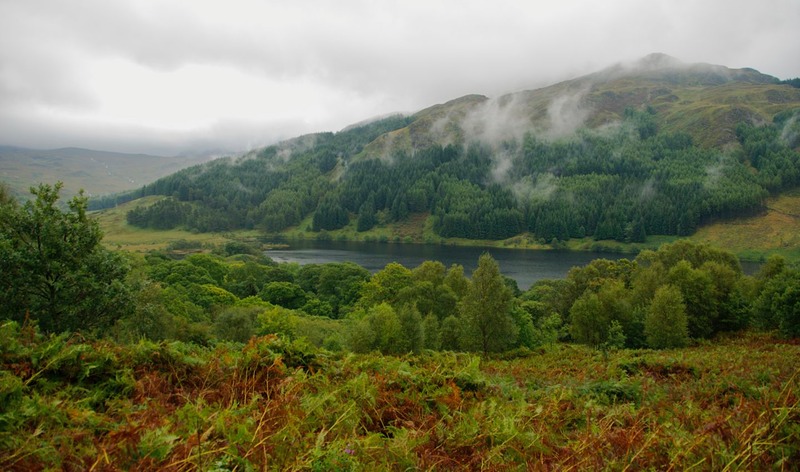
Even the first night off the boat we knew we were in a different land; we were reminded of British Columbia, what with all the forests and lakes and logging. We camped in a wooded glade in the Galloway National Forest, and the next morning found the Robert the Bruce Memorial, Bruce’s Stone, nearby. This guy is a huge national hero and there are many locations doing homage; this was on a promontory overlooking a lovely valley where The Bruce, as he is sometimes called, won a small engagement in 1307. A gigantic stone on a promontory overlooking a lovely lake pays tribute to his deeds. It was very evocative.
Even though we were making a beeline for the Orkney Islands, we didn’t miss all that much along the way: Loch Lomond and environs; the beautiful lakeside resort of Oban with its castle and lots of charm; and particularly Glen Coe National Park. What an awesome place; it reminded us of Torrey del Paine NP in Patagonia. It was here that we decided to join the National Trust. We had avoided it in England, Wales, and Ireland; but the focus here in Scotland is different and we could see that many of the places we wanted to see were under their wing. So – what the hey!
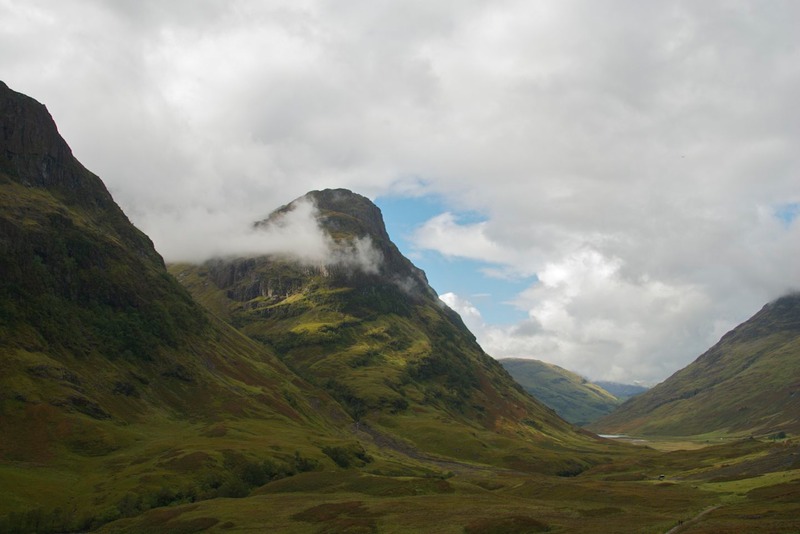
Glen Coe is a land of mountains and rivers and glaciation, and a road that goes to the top of the pass through awesome scenery. It was rainy and misty but we took lots of pictures anyway, and then spent some time poking around the visitor’s centre. There were lots of displays, many of them discussing the various kinds of people who make use of the area; one very interesting group were mountain climbers (now these aren’t high peaks – nothing more than around 3,000 feet) who were described as daft – in the ancient Scottish this means something like “extraordinarily happy” as opposed to the well known modern definition of, well, you know. Rick and I looked at each other and said “that’s us!” -- by either definition, many folks do think we’re quite daft.
The Glen Coe area lies near a series of lochs located along a natural fault – a huge crack in the earth -- that leads northeast to Inverness. This is a very pretty area and we traveled along, enjoying our “loch experience.” The approach to Inverness is along Loch Ness; no, we didn’t see her, but then we didn’t try really hard. The entire area looked a lot like the Finger Lakes district in upstate New York.
Inverness lies on the Moray Firth – a firth is an estuary, this one leading out into the North Sea. Inverness is a great town, with lots to see and do. At this point we were checking on ferries out to the Orkneys and they were a great help. We also picked up a brochure on what was going on in the area, and – surprise – there was a concert that same evening that would be held in Thurso, up on the north shore. How far to Thurso from here? Less than 3 hours, we learned. So we hot-footed it up the eastern shore, along the headlands and bogs, through the sheep and the heather, on up the hill (pant, pant) to get to Thurso in time for the concert.
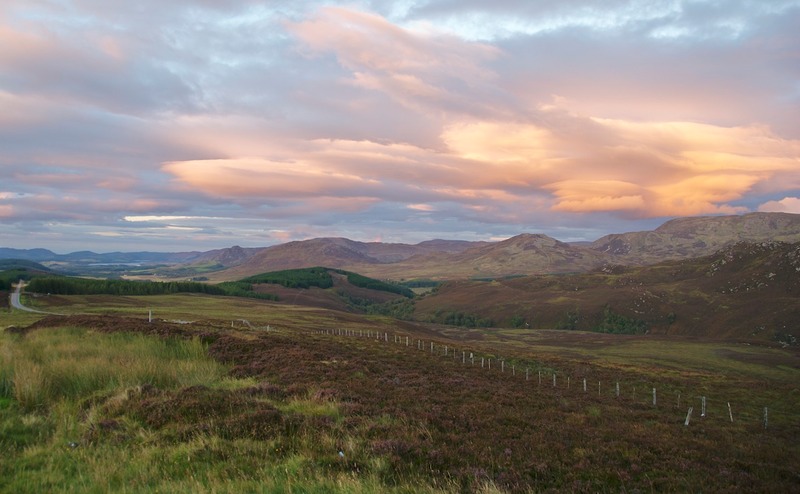
It was a hoot, and well worth the bother. No bother, really; we were coming through this area anyway. The concert was a sort of “outreach” performance put on as part of the Blas series, which is centered in Inverness every September. A celebration of Highland music, it’s huge, it’s supported by the government, and it’s terrific. What we saw was a combination of acts starting with a local children’s choir accompanying itself with simple instruments; they were okay. The highlight for us was a tenor with an incredible voice, singing traditional Gaelic songs and accompanied by a keyboard and cello. The trio was outstanding. The last act – hard to describe – was several young folks in a band, all former Glasgow music students apparently, singing and playing various instruments, and including not just one but two fellows on the bagpipes. Miked. In a relatively small room. More amps than necessary, but they were having a ball, and their fiddler was outstanding. We had a great evening, chatting with the locals there to support their kids and others attending for the more serious performances. A great intro to the northern Highlands, and as a secondary title for this message we’ve adopted the slogan from the Blas series, Maladh na Gàidhealtachd, or Celebrate the Highlands. By the way, we learned that in Scotland, the Gaelic language is pronounced ‘gal-ic’ rather than ‘gay-lic’ as it is in Ireland.
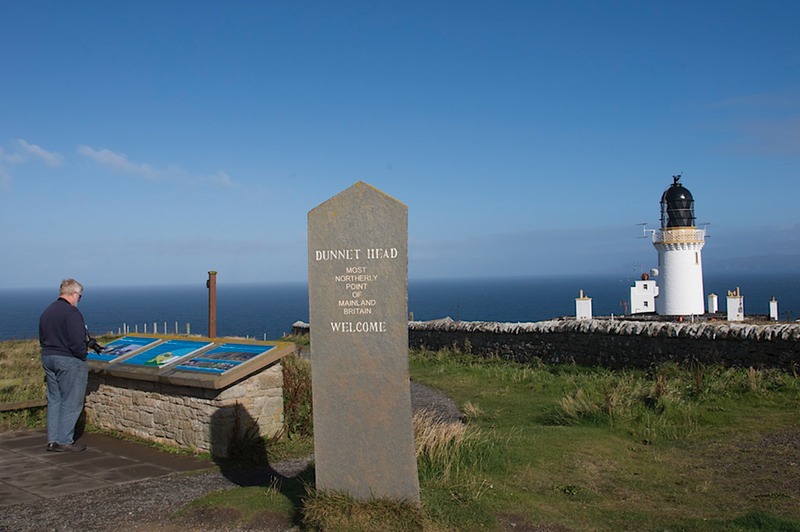
Something new for us was that the announcer (who was the tenor we enjoyed so much) made all his comments in Gaelic, which he then translated. The performers also did the same. We were very aware of the attempt being made to continue “the old ways” -- traditional music, schools in the Gaelic language, signage – that we were seeing. The kids, as they introduced their songs, spoke Gaelic. We had seen a lot of this in Ireland and Wales as well; it was quite heartening.
The next day we sampled the little towns further east along the very flat north shore, including John O’Groats (boring) and the lighthouses at Dunnet and Duncansby Heads. At 58⁰ 40.222, Dunnet Head is the northernmost point on the mainland of Britain. A significant place on the way to the Orkney ferry at Gill’s Bay.
In preparing for this part of the trip, we had stocked up on food for several days, assuming that the Orkney Islands were a tiny outpost and that we might have difficulty finding fresh milk, for instance. Not so. We arrived and were greeted by the same supermarkets we’d been seeing everywhere else. Now, we know this wasn’t true back in time, but modern Orkney is not at the end of the world.
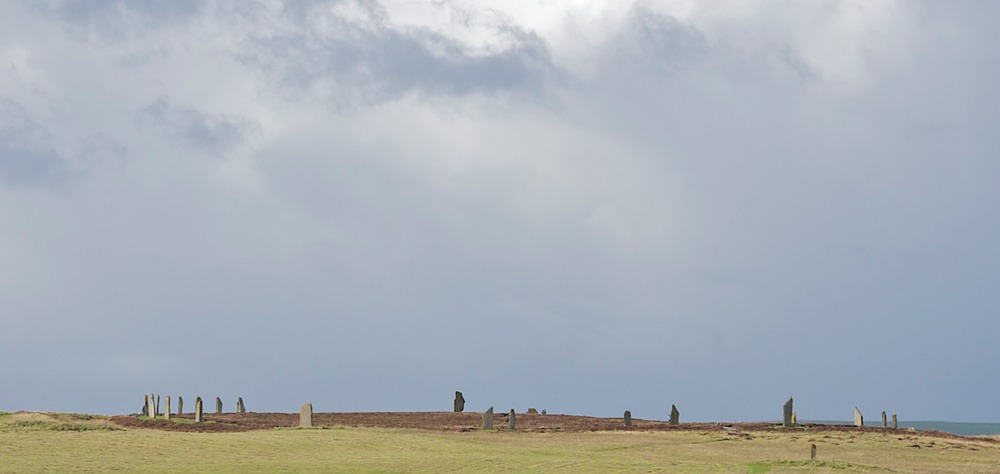
Well, Orkney is really cool, and that’s what they’re called, not “The Orkneys”, even though there are several islands in the group. We had some good weather and plenty of rain, but we carried on. Kathy got to visit several very important and significant sites, wallowing among the standing stones, the rings, the uncovered village at Scara Brae; fantastic!! This is the second site we’d visited where they’ve uncovered actual 5,000 year-old homes with stone furniture intact.. We even searched out the memorial to Lord Kitchener; it seems he had died in a suspicious shipwreck off the coast. Orkney has a very strong Norwegian influence, which we saw in the lovely St. Magnus Cathedral at Kirkwall. As a contrast, there is a small chapel built by Italian prisoners of war during WWII, brought to the islands to help build a causeway.
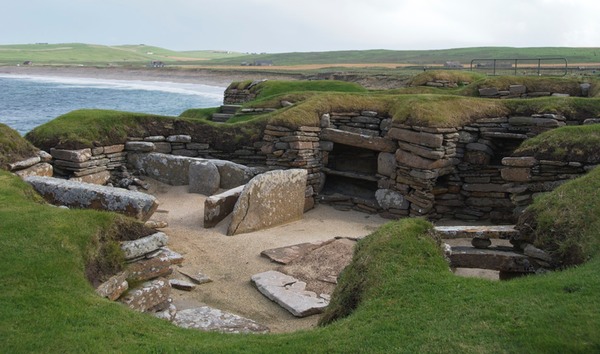
Orkney was very windy, and the wind would continue throughout much of our time in the Highlands; it was also getting colder and rainier, so it was time to go. We decided that Orkney was the Land of Many Rainbows as the weather conditions alternated rapidly from dark to sunny, wet to dry – and then back again.
Back on the mainland, we took off west along the top of Scotland, and began to explore the western Highlands; we were immediately blown away (almost literally at times) by how spectacular the area was. It’s very rugged. We had expected traditional mountains – high peaks, sharp spires – like we were used to in the U.S. There were some jagged and even forested spots, but in general these mountains were barren, smooth mounds. We found out later (thank you, Malcolm) that these mountains are quite ancient, and have simply been worn down to their granite base.
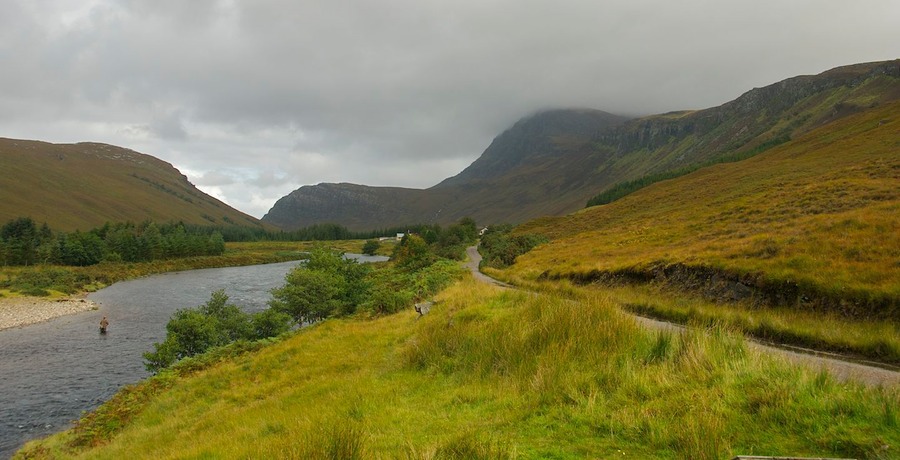
It’s very isolated country, and we saw many folks living in very small stone houses. Strange names: Tongue (really!), Scourie, Upper Badcall (a retired umpire?) and around Ben Hope; about as remote as we have been so far in Europe. It rained a lot; we dubbed northern Scotland the Land of Squalls and Zephyrs and Sunshine. We saw rocky headlands and small lochs; then we’d reach a coastline with its fishing village and small bay. It was wild and wonderful. There were waterfalls everywhere. The roads were mostly single-track, which we liked very much. A single-track road is only wide enough for one vehicle, but has turn-outs every quarter mile; very civilized, and everyone takes turns. This is as opposed to the rest of the roads, which are only about a lane and a half wide but with a stripe down the middle, few turnouts, and no one behaves themselves. We much preferred the single tracks.
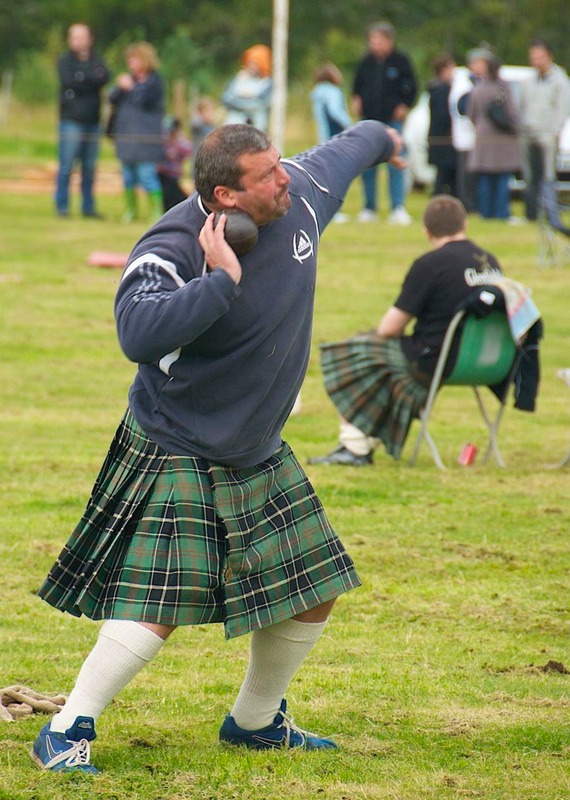
Yes, of course we saw lots of Highland cattle; we even got a few of them to pay enough attention to have their picture taken. Mostly they just ate.
We were moving further south as we explored. The leaves were seriously turning, the geese were overhead, and we were just a tad twitchy. We dropped down out of the “world apart” part way back into civilization. A little north of Ullapool we aimed a bit southeast for some late season Highland games we’d read about, to be held outside Bonner Bridge. We got lucky and the weather cooperated, giving us a fine day out among the tartans, dancers, pipers, and very-large-men-flinging-various-large-and-dangerous-objects. There were teenage girls everywhere, dolled up in their finery – and “party Wellies”, brightly covered rubber boots. And Rick discovered tablet, a Scottish dessert; lovely.
We were in softer, greener pastures, with rolling hills and open fields; pheasants were everywhere – in the mowed fields, along the roads, in the way, you name it. The season was changing. So were the leaves. But we weren’t done with this area, and after the games we went further west, into the Wester Ross. Lovely countryside throughout, particularly in the area between Kinlochewe and Torridon; and by now we’d lost the strong winds. We slept better at night, that’s for sure. We had lots of rain, but also lots of good weather, and a lovely coastline. We’ve decided, by the way, that regardless of when we reach a stretch of seashore, it will always be low tide. It is our karma. We’ve seen more mudflats here than anywhere since the Bay of Fundy in Nova Scotia.
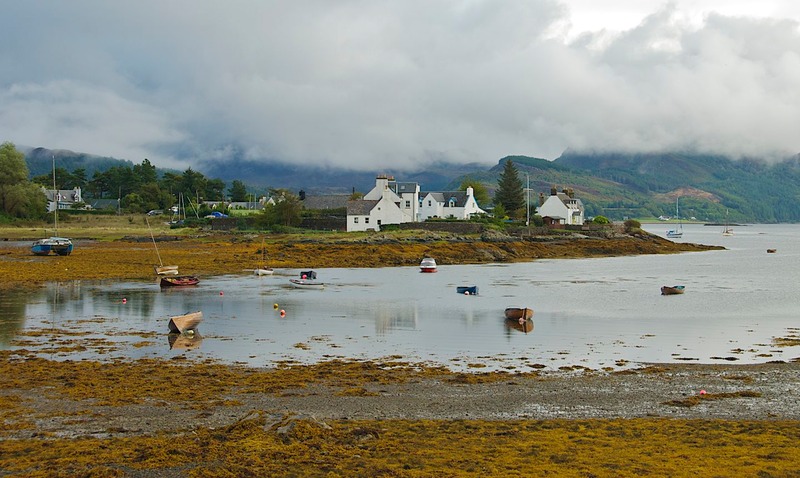
Two of our favorite road signs, seen all over Scotland, were “Blind Summit” and “Hidden Dip”; tells you what a roller-coaster ride Scotland can be. And always with the chance of a cyclist in exactly the wrong place. One afternoon we very much enjoyed a parade of classic sports cars coming along the single-track in the opposite direction. They were taking part in a rally and we were delighted to move aside and watch them pass by. It was misty and rainy, but most of them had their tops off anyway. They came along in ones and twos over a period of about 2 hours; it was very entertaining.
We stopped at Plockton and Kyle of Lochalsh for a bit, and then made a brief foray out onto the Isle of Skye, loved by everyone. Unfortunately, the main attraction is the Cuillen Hills and as we headed towards them we found ourselves climbing right up into the clouds. With no chance of views, we poked around for a few hours and then continued back onto the mainland, headed for Glenfinnan.
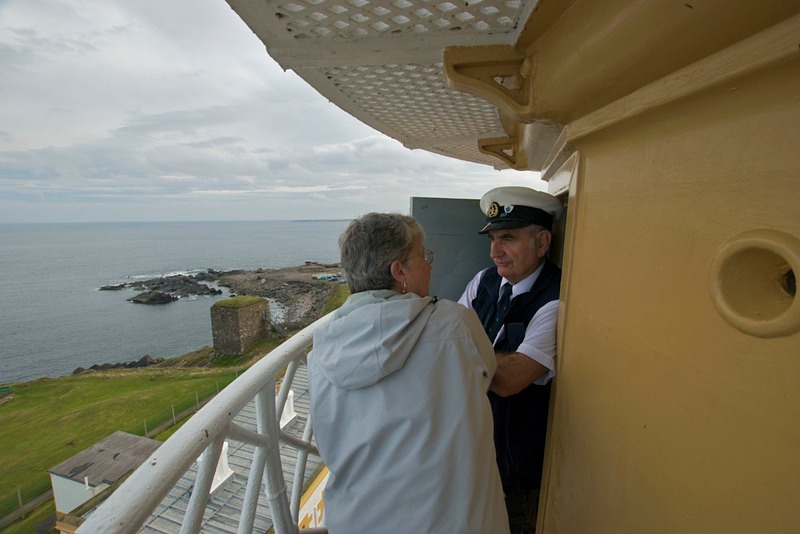
Now Glenfinnan was cool. It’s several things: a monument, a visitor’s centre, an important moment in history. It’s located in a beautiful spot at the head of Loch Shiel. It is here that Bonnie Prince Charlie came ashore in 1745 hoping to assert his claim to the throne of Scotland. The monument is sacred, the visitor’s centre quite informative, and the man was a legitimate hero to his people despite his lack of success.
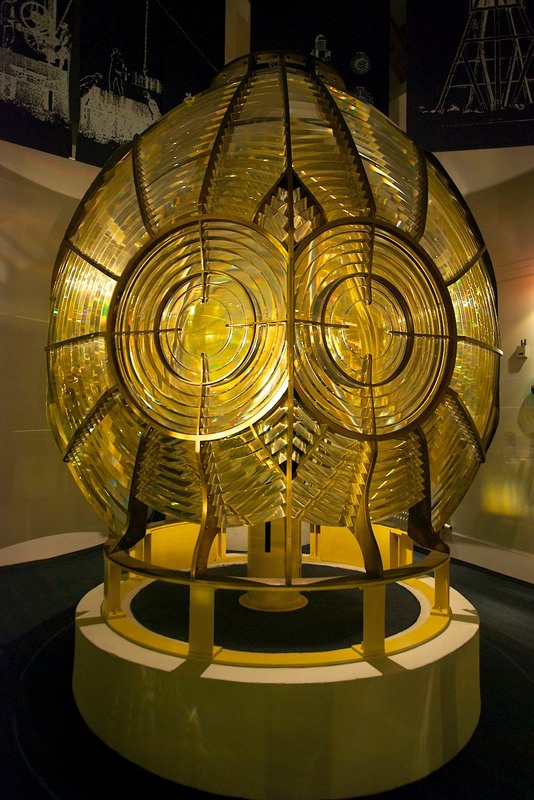
Time was passing; we needed to move on down the hill. Scotland is divided into areas; we’d seen the northern sections and the southwest; now we were heading further east. We moved through Inverness again, then along the shore of the Moray Firth and along the North Sea. We knew we were covering a lot of miles at about $7/gallon, and that we needed to try harder to keep on more of a straight and narrow path south towards England. But what the heck, in the end this didn’t keep us from heading out along the coast to Fraserburgh, home of the Scottish Lighthouse Museum. You see, we really like lighthouses and ships and stuff. This was great; it was home to the oldest lighthouse in Scotland and our tour guide was the gentleman who had been the last keeper before the light was automated in the late 1990’s. He was terrific, taking us all over the property and up into the light itself. Great fun. The museum was excellent, home to a number of the beautiful old lights and lenses that had been in use in Scotland. We had a great time.
Now we’re getting serious rain, more rain than sun. We learned that there were hurricanes in North America, and some of the rain was a side “benefit.” Moving south and skirting Aberdeen, we spent a delightful night on the grounds of a manor house near Methlick, Haddo House, with lovely walking paths through its forest. Early in the evening, the parking lot suddenly began to fill and we wondered what was going on. It seems there was an amateur choral group coming in for rehearsals of a concert they were giving in Aberdeen that Saturday: Bach’s B-Minor Mass. Well cool; we were invited to come listen in; the hall was very rustic, with many heads of game animals on the walls; we had a good time. Quite an experience.
At my request, Rick stopped in Lumphanan for me to look at some stone ruins. An added bonus was discovering that Macbeth (himself) had been killed there, not at Dunsinane (nearby) as Shakespeare had so eloquently represented. And we had passed by Birnum Wood the day before; neato!
We trucked on past Balmoral Castle (wiser than we in the ways of British weather, the Queen had already come and gone), in a lovely area along the River Dee, down the Glen Shee Valley; and suddenly into a somewhat gentler version of the barren west Highlands. We climbed to 2200 feet over the Glenshee Pass, the highest in Scotland.
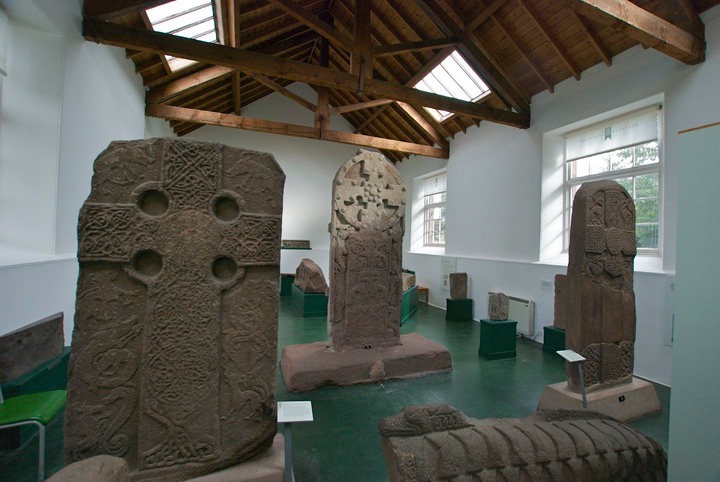
Folks were talking snow – not today, not tomorrow, but soon. But we were having lovely weather. We stopped at the Sculptured Stones Museum in Meigle, and I fell in love – welcome to the ‘Kathy does Ancient Stones Tour’. Pictish works; amazing stuff. The Picts weren’t a separate group of early inhabitants, but a number of Celtic tribes who banded together in order to better fight against their enemies; they chose to tattoo their bodies (like in New Zealand), and the Romans called them Picts because of the pictures they drew on themselves. The museum had a large collection of the stones that decorated their graves. Awesome.
So many of the areas we are visiting remind us of eastern Canada; we can understand quite easily why settlers called their new home Nova Scotia.
The Trossachs, near Stirling and not that far from Glasgow and Edinburgh, were filled with folks enjoying a lovely fall weekend. They are called the “Little Highlands”, and make a great spot to visit. The area is famous for its connection to both Sir Walter Scott and Rob Roy (who apparently was a bit more of a scamp than the movies have made him out to be).
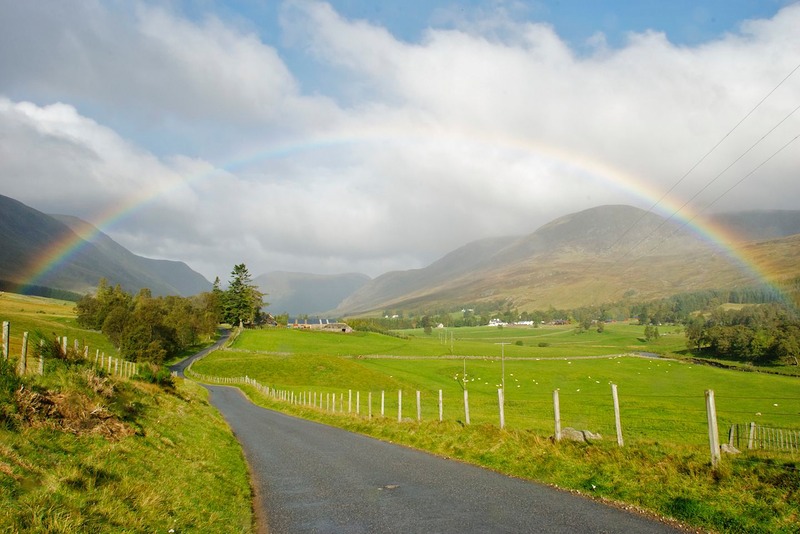
We had to bypass some spots we would have like to have visited and some people we knew nothing about: we missed St. Andrews for one; and somewhere there was a memorial to Cunninghame Graham, and we never found out who…
But we didn’t miss Stirling, with its great castle, a big Victorian monument to William Wallace of “Braveheart” fame, and… a guy who was able to service the truck and fix some minor problems. We were quite delighted with them all. We visited the town on a misty, moisty morning. The Wallace monument stands tall on a hill overlooking the town; very imposing. At the castle, the highlight was a chance to watch and talk to the people who are weaving new tapestries to be hung in the rooms of the castle that are currently under refurbishment. They are being done in the “old way” and it’s fascinating to watch. The tapestry currently being woven will have taken 4 years by the time it is completed. Several others were already completed and hung for display; they are absolutely beautiful.
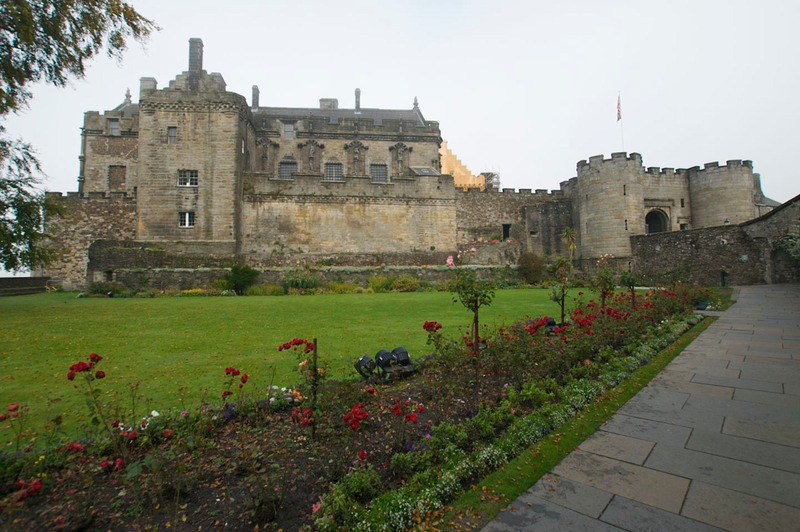
One night we shared a layby on the north edge of Stirling with some Scots who came in after we’d retired, and left early the next day. But shortly we got a charming message from them; they lived in Glasgow, would love to meet us, and if at all possible to come on by. So the next day we met Susan and Malcolm MacAskill, new and good friends. They showed us around Glasgow, fed us well (including haggis, which Rick passed up but Kathy mightily enjoyed – it arrived complete with a Robert Burns poem and a ceremonial stabbing of the “beast” – I loved it!).
We also checked out the Falkirk Wheel, a marvelous feat of engineering that replaced eleven locks in lifting boats from one canal to another.
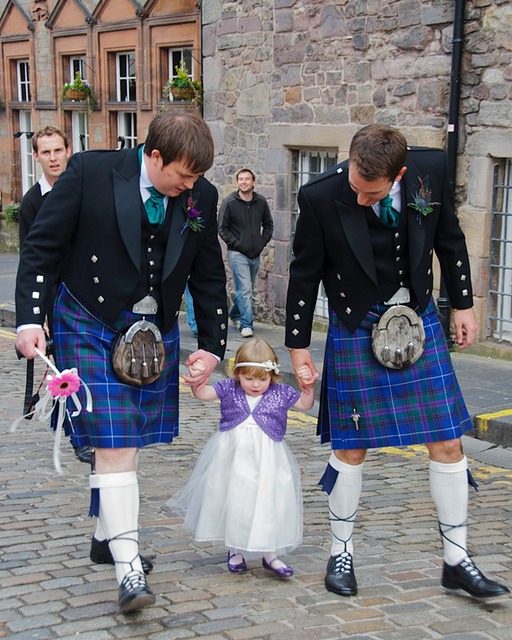
And then we hiked over the hill to Edinburgh. What a great city! We wandered around the castle and checked out all the folks walking around the streets in the old part of the city. The castle is a popular spot for weddings, we discovered; there were at least two that afternoon, and folks were coming and going in all their finery the whole time we were there. We spent a day at the National Museum of Scotland, a terrific site. They had so many of those ancient stones I’d been chasing for the last few weeks, along with lots of jewelry and leather goods that had survived in the bogs; it was really cool. The presentation of the materials was very innovative, and quite impressive. I spent most of my time communing with them. Another find was the Scottish Sports Legends room where one of the biggies (literally) was Bill Anderson, 16-times Scottish Highland Games Champion. The picture showing him throwing the traditional large stone they used to use, back when men were men and stones were, well, stones (before they were replaced with more “modern” steel weights) was quite incredible. Rick also discovered info on motor racing legend Jim Clark in the Scottish sports heroes area, and a few days later we went to a museum about him, in the small village of Duns, where he had lived.
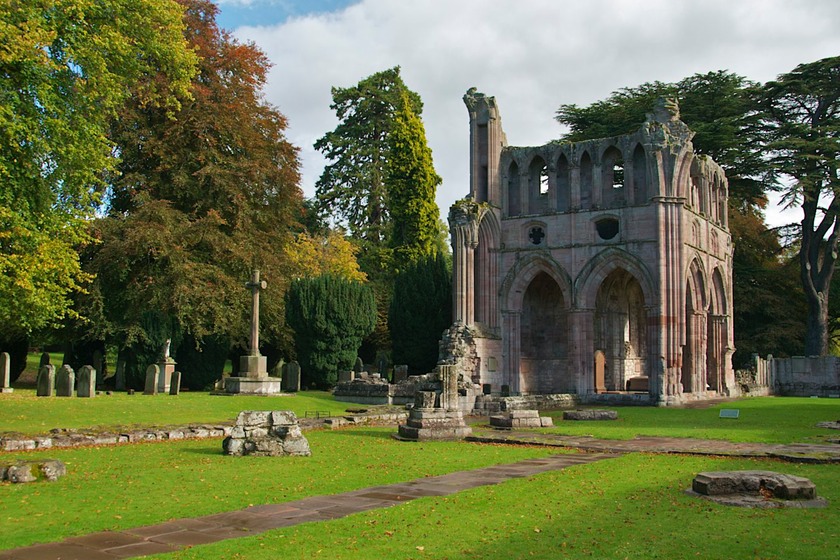
Southeast of Edinburgh we wandered the moors, then hit the Border Counties, an area of lovely rolling hills and farmland, splendid ruined abbeys to explore, warmer weather, and funky memorials to old heroes. We visited some of each, including a wacky memorial to (Lord) William Wallace (yup – himself, again). We also ducked back far enough north to visit Rosslyn Chapel. This is a very interesting, very old chapel, made very famous by the movie The DaVinci Code. It sits in a small village, which was changed forever when Hollywood arrived. But everyone has survived, and long-delayed refurbishment and conservation work is underway on this jewel of a small building – several years sooner than would have been possible otherwise. The number of visitors has risen dramatically, and the resultant money is making much possible, while no doubt driving many locals to distraction. Unfortunately, the outside of the chapel was covered in scaffolding and photos were not allowed inside.
We continue to find ourselves tripping over pheasants every day, and the geese are noisy and plentiful overhead. And then we chatted with a man in a village park who comes and feeds the ducks (and an errant heron) each afternoon; been doing it every day since his retirement nine years ago. Well, not quite everyday, he only comes on Sunday in the wintertime. Birds everywhere! Bet you hunters wish we could ship some of those pheasants your way…
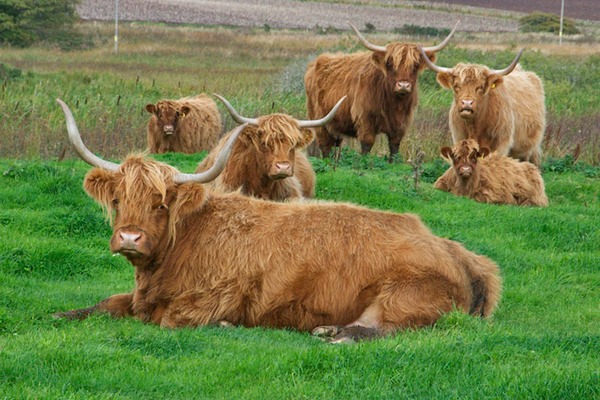
Our last night in Scotland was spent with a couple we had met in France back in May. The pleasures of our lifestyle had given us the chance to meet Robert and Frances Togneri, and we had a lovely afternoon and evening visiting with them in their home, which was built in 1723. They also fed us well and sent us on our way full of local breakfast delicacies. We will hope to see them again down the road. From there we passed through Gretna Green, just over the border from England, where back in history eloping English couples would come to be married by the local blacksmith. Very romantic. Then across the border and we were in England once again, after two months wandering in Wales, Ireland, and Scotland
Having concluded our time in Scotland, we began heading south in earnest with our sights firmly set on Dover, a ferry back to France, and roads that will take us south toward warmer weather. But you can be sure that we definitely plan to hasten back to Scotland for another visit. There’s so much more to see.
We send you wet and shivering good wishes for a Happy Halloween.
Rick, Kathy and the girls (for anyone not paying attention, that’s La Tortuga, Emily, and Da Diva, aka the wifi device that has let us get on line so well here in the UK.)